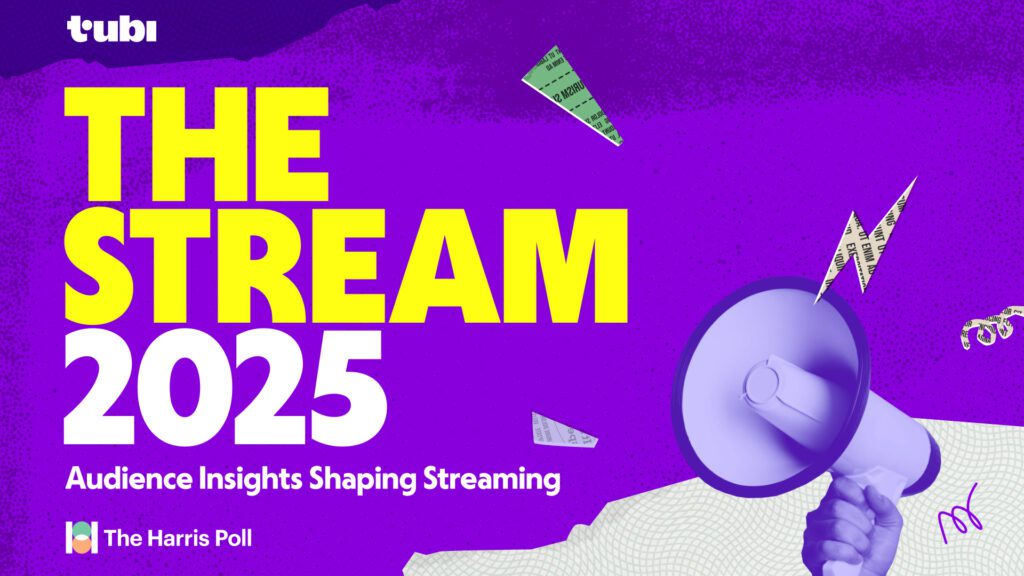As streaming enters a new phase of maturity, evolving consumer expectations are reshaping how audiences engage with content. The latest research from Tubi and The Harris Poll, captured in The Stream 2025: Audience Insights Shaping Streaming, offers a deep dive into these shifting trends. The study surveyed 2,502 U.S. adults who stream at least one hour per week, with a spotlight on Gen Z—whose habits are shaping the future of streaming entertainment.

The report highlights a growing divide between ad-supported and subscription-based streaming, reveals how price hikes are leading to increased churn, and explores changing content preferences—including a resurgence in nostalgic content. It also uncovers surprising insights into how streaming impacts the workplace, relationships, and advertising engagement.
Streaming as the Preferred Form of Escapism
Streaming has surpassed social media as the top form of entertainment and relaxation. According to the study, 80% of viewers say they would rather watch a TV show or movie than scroll through social media.
When in need of a mental break:
- 59% turn to streaming,
- while 50% listen to music
- and 38% scroll social media.
The study also found that streaming remains a deeply ingrained habit. 57% of viewers watch TV and movies for 1-3 hours in one sitting, and 38% watch for more than 3 hours. This behavior spans multiple streaming services, as consumers juggle an average of nearly seven platforms—3.9 paid and 2.6 free services.
Rising Costs Are Driving Subscription Fatigue
As subscription costs climb, viewers are becoming more selective about the services they keep. Consumers now spend an average of $129 per month on streaming and paid TV services, up 7.5% from the previous year. With streaming bills surpassing their spending on clothing ($109/month), 56% of respondents closely monitor their streaming expenses to avoid overspending.
For Gen Z, affordability is key. 76% say they have canceled or would cancel a subscription due to price hikes, highlighting a significant challenge for streaming platforms. Subscription churn is another issue: 67% of Gen Z streamers say they have canceled a service after finishing a show they liked because they didn’t see any other compelling content on the platform.
Beyond price increases, other major reasons for canceling a subscription include content removal (66%), tiered memberships (63%), and password-sharing crackdowns (45%). As a result, more than a quarter of Gen Z streamers expect to use fewer streaming services in the future.
Ad Tolerance: Free vs. Paid Streaming Preferences
Consumers are open to ad-supported models, but expectations vary depending on whether they are paying for the service. The survey found that 79% of viewers believe that if they pay for a streaming subscription, they should not see any ads. However, when using free platforms, 81% consider ads an acceptable trade-off for content access.
Many consumers are willing to endure commercials if it means lower costs. 63% say they would accept ads in exchange for a lower subscription price, up 5% from the previous year.
However, the study revealed that poorly targeted ads frustrate many viewers. While 59% of streamers say they would take action if an ad aligns with their interests, 73% of Gen Z respondents feel that the ads they currently see on streaming do not match their personal preferences. Additionally, 46% of Gen Z viewers say irrelevant ads disrupt their streaming experience.
The Rise of Nostalgia and Demand for Original Stories
A major trend emerging from the report is the growing interest in both nostalgic content and original storytelling. Viewers are actively seeking classic shows and movies from past decades. 66% say they enjoy discovering TV shows and movies that were originally released more than 10 years ago.
For Gen Z, nostalgia plays an even bigger role: 87% agree that streaming platforms should show them older content they’ve never seen before, in addition to new programming. This trend, referred to as “new-stalgia,” has helped classic shows like Friends and The Office remain relevant across generations.
At the same time, viewers increasingly favor independent productions over reboots and franchises. 70% of streamers want to see more TV shows and movies from independent or smaller creators, a 4% increase from last year. Among Gen Z, 73% prefer original content over franchises and remakes, and 72% wish they had more of a say in the type of content that gets made for streaming services.
The Role of Free Streaming Platforms in Content Discovery
Viewers associate free streaming platforms with a broader selection of content. According to the study, 58% of audiences turn to free services to explore a wide range of programming, 54% seek out different genres, and 40% look for new or original content.
Tubi has capitalized on this trend with its innovative Stubios program, launched in October 2024. Stubios is an interactive, fan-driven studio that connects non-traditional creators with advertisers and audiences. The initiative has already received over 2,000 submissions, with four inaugural projects currently in production. Tubi has committed to funding the top-voted project and distributing it to 97 million monthly Tubi viewers.
Streaming at Work: A New Workplace Trend
The report also uncovered a growing trend of employees streaming while on the job. Half of Gen Z respondents admitted to watching content while working from home, with 48% confessing they have lied to their bosses about it. Even in traditional office settings, 38% of viewers reported streaming at their job sites.
Additionally, 53% of Gen Z streamers said they have postponed work to finish binge-watching a show, and 52% said they don’t want to return to the office because they would miss streaming during the workday. This finding suggests that streaming is not just a form of entertainment but also a source of relaxation and escapism in daily life.
Streaming and Relationships: Password Sharing and Viewing Habits Matter
Streaming habits are increasingly influencing relationships. The study found that 70% of single consumers refuse to share their streaming login with a romantic partner until the relationship becomes serious. Meanwhile, 44% of Gen Z users admitted to continuing to use an ex’s streaming account after a breakup.
Beyond password sharing, taste in content is also a factor in relationships. The report revealed that 35% of Gen Z and Millennials have ended relationships over incompatible viewing habits, underscoring the role of entertainment preferences in modern dating.
The Future of Streaming: Balancing Cost, Content, and Consumer Expectations
As streaming platforms face increasing competition, consumers are becoming more selective about where they spend their money and time. While ad-supported models are gaining acceptance, platforms need to improve ad targeting to ensure a seamless experience. Subscription services must also strike a balance between pricing, content availability, and personalization to retain users.
With the rise of nostalgia-driven content consumption and the demand for fresh, independent stories, platforms that offer both classic and innovative programming will be best positioned for long-term success.
Additionally, consumer behavior is shifting in ways that require new engagement strategies. Whether it’s the “new-stalgia” phenomenon, increased streaming at work, or evolving expectations around password sharing, streaming services must continuously adapt to keep audiences engaged.
The key takeaway? Streaming is no longer just about content—it’s about creating an experience that aligns with viewer preferences, behaviors, and budgets. Platforms that master this balance will shape the future of entertainment.







